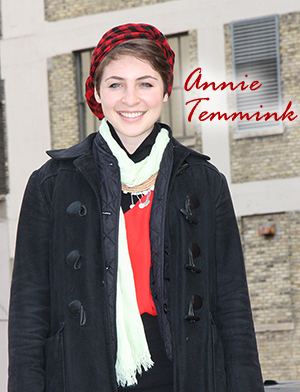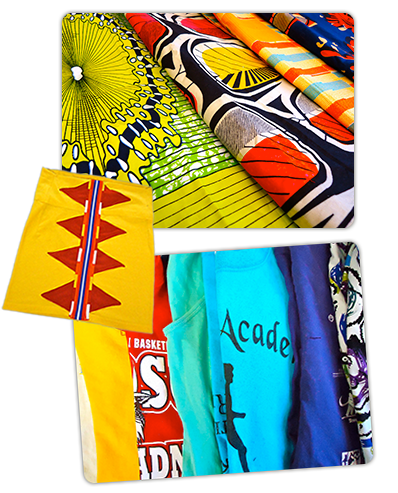 I fell in love with African print fabrics in Ghana. They are bold, covered in big designs and have no fear of being too colorful or too expressive. When I am home I remark what a contrast this is to the American, often monochromatic, wardrobe. Our t-shirts however, come in the full rainbow of colors; they just need a little more sophistication. So this week you don’t have to go all the way to West Africa to add some color and confidence to your wardrobe. You just need a few t-shirts in your favorite colors from Goodwill. While you’re there, also look for stretchy patterned shirts, skirts or jackets whose fabric or embellishments you can use to complement those t-shirts. Certainly don’t shy away from bright colors: the point is for bolder to be better.
I fell in love with African print fabrics in Ghana. They are bold, covered in big designs and have no fear of being too colorful or too expressive. When I am home I remark what a contrast this is to the American, often monochromatic, wardrobe. Our t-shirts however, come in the full rainbow of colors; they just need a little more sophistication. So this week you don’t have to go all the way to West Africa to add some color and confidence to your wardrobe. You just need a few t-shirts in your favorite colors from Goodwill. While you’re there, also look for stretchy patterned shirts, skirts or jackets whose fabric or embellishments you can use to complement those t-shirts. Certainly don’t shy away from bright colors: the point is for bolder to be better.
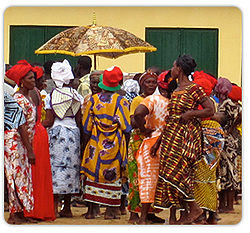 Two things struck me during my month long stay in Ghana (West Africa) that changed the way I think about clothing. The first were the loud patterns and bright colors of their fabrics. The second were the women and the confidence with which they carried themselves.
Two things struck me during my month long stay in Ghana (West Africa) that changed the way I think about clothing. The first were the loud patterns and bright colors of their fabrics. The second were the women and the confidence with which they carried themselves.
Breathtakingly beautiful and unabashedly confident, I never saw a Ghanaian woman (big, curvy, and powerful) just walk, but strut: these bright patterns swishing over her hips with the kind of grace and poise I don’t often see in the United States (particularly not with heavier American women). When a Ghanaian woman enters a room you will always know it. And it never seemed like clothing was what made the woman. Her confidence was internal and it was part of her body language so that whatever she wore had no choice but to look great. Witnessing this kind of archetypal, powerful woman changed the way I look at dressing. Clothing is secondary; first you have to put on the right confidence.
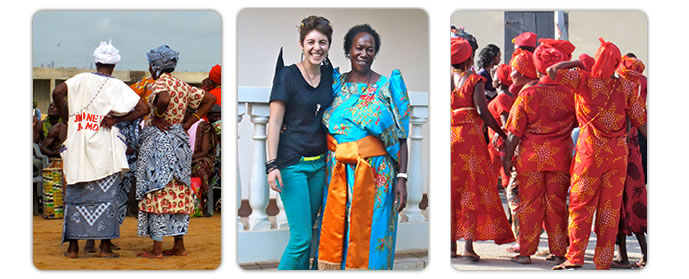 |
|
Center photo is with the woman who so graciously let me stay with her family (she's wearing a traditional Gomesi, Ugandan traditional wear, for an event). One of the most brazen women I know! |
This project requires 2 t-shirts and the embellishment from a jacket (or ribbon).
 1. Pick the shirt that will be the main color of your skirt. If you can find a stretchy tank top (make sure it’s not too thin) those actually work better than t-shirts for the base of the skirt because they have a little more stretch. Measure the length you want for your skirt (+ ½ an inch for seam allowance) from the bottom up, and cut to that height (this will give you a tube of fabric with a finished bottom edge). Measure the size of your hips and sew a seam down the middle of your skirt to give you that circumference (or an inch or two less than your hip measurement if you want it to be more fitted). Cut off the extra fabric at the seam.
1. Pick the shirt that will be the main color of your skirt. If you can find a stretchy tank top (make sure it’s not too thin) those actually work better than t-shirts for the base of the skirt because they have a little more stretch. Measure the length you want for your skirt (+ ½ an inch for seam allowance) from the bottom up, and cut to that height (this will give you a tube of fabric with a finished bottom edge). Measure the size of your hips and sew a seam down the middle of your skirt to give you that circumference (or an inch or two less than your hip measurement if you want it to be more fitted). Cut off the extra fabric at the seam.
You will have a rectangle that fits around your hips, but not your waist. Put the skirt on, and pinch in the extra fabric until the skirt fits as you would like it to. Then sew down this extra fabric (in darts or small triangles) to take out the excess fabric at the top of your skirt. You could also make two side seams instead and angle them in at the top, but I only wanted one seam for this design.
2. Next cut two rectangles for your waistband. They should be double the final height you want, plus an inch of seam allowance. Sew the two pieces together with a V on both sides, where the point of the V will mark the top of the waist band (and should be a little more narrow than your waist) The lower edges should be the same size as the top of the other part of your skirt.
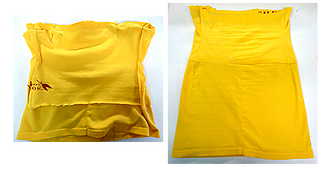 3. With right sides together, pin the lower edge of the waistband to the top of your skirt. Sew together.
3. With right sides together, pin the lower edge of the waistband to the top of your skirt. Sew together.
4. Now comes the fun part: adding patterns, and colors. I was inspired by this Zulu tribal skirt I saw in the book: The World Wide History Of Dress. (Books of tribal and traditional dress are great places to get inspiration. They are filled will magical things.)
5. I added red diamond shapes to mine (which I cut from a second t-shirt) to make a bolder, more graphic skirt. If you remove the collar, sleeves and shoulder seams from your extra t-shirt it makes cutting out shapes much easier. I also cut out a paper pattern to use as a cutting guide.

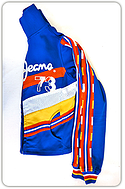 6. I like to cut my shapes ½ an inch bigger than I want them to be so that I can fold the edges under (this gives a cleaner look). Knit fabrics wont fray so if you’d rather, you can just cut them to the size you like and sew them to your base skirt with a zig-zag stich (no folding required).
6. I like to cut my shapes ½ an inch bigger than I want them to be so that I can fold the edges under (this gives a cleaner look). Knit fabrics wont fray so if you’d rather, you can just cut them to the size you like and sew them to your base skirt with a zig-zag stich (no folding required).
7. After preparing all of your shapes, lay out your design and pin. (my design covers up the middle seam). Sew down your shapes using a zig-zag stich (straight stiches will pop when stretched). If you are using other embellishments remove them with a seam ripper and pin them to your skirt.
8. When I was at Goodwill I found a jacket with great stripes to use for the central part of the skirt.You might also find clothing with interesting patterns or details that you can use in your project. Any jersey or stretch material will work well (try to find materials with similar weights).

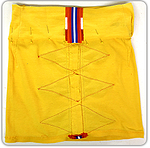 9. When you’ve sewn all of your parts down, turn inside out, and sew the waistband down on the inside.
9. When you’ve sewn all of your parts down, turn inside out, and sew the waistband down on the inside.
10. Voila. Your own African print inspired skirt, with big shapes and bright colors for spring and summer. Now just get that walk and wear your confidence, too.
|
A dress I made for Klaire (the Ugandan model pictured) from Ghanian fabric. |
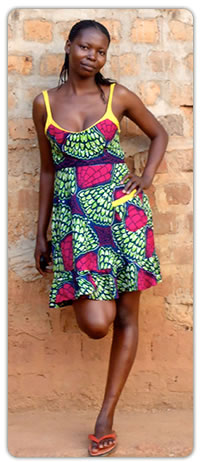 |

